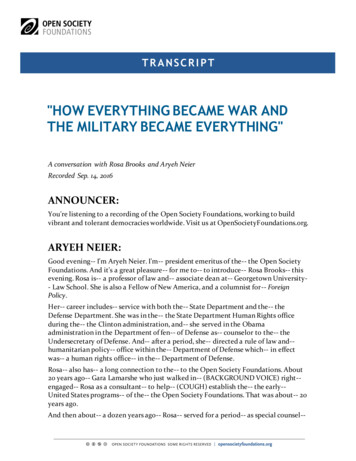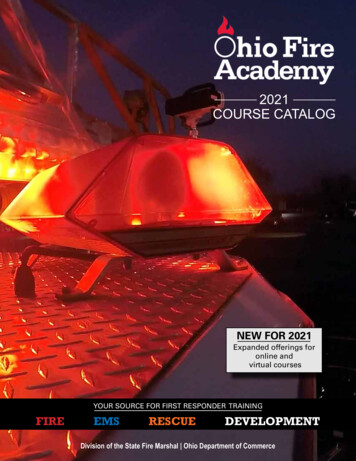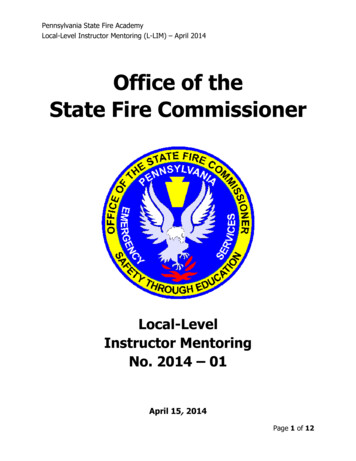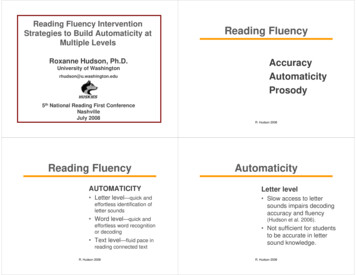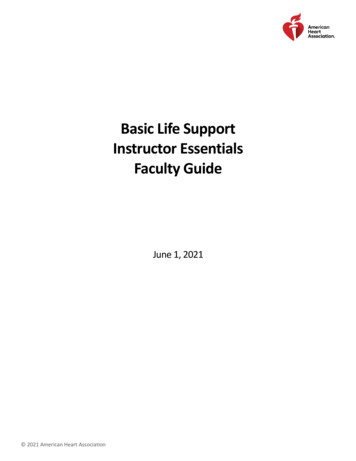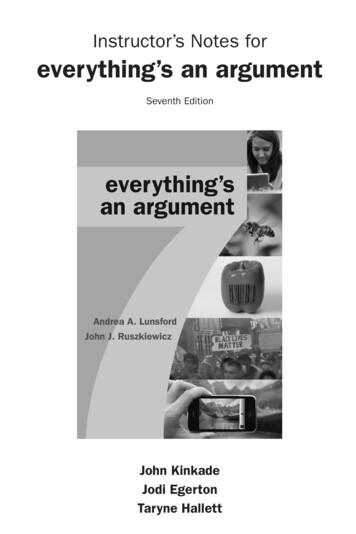
Transcription
Instructor’s Notes foreverything’s an argumentSeventh EditionJohn KinkadeJodi EgertonTaryne Hallett
Instructor’s NotesEverything’s an ArgumentSeventh EditionAndrea A. LunsfordJohn J. RuszkiewiczPrepared by John Kinkade, Jodi Egerton,and Taryne HallettBedford /St. Martin’sA Macmillan Education ImprintBoston New York
Copyright 2016, 2013, 2010, 2007 by Bedford/St. Martin’sAll rights reserved.Instructors who have adopted Everything’s an Argument, Seventh Edition, as a textbook for a course are authorized toduplicate portions of this manual for their students.For information, write: Bedford/St. Martin’s, 75 Arlington Street,Boston, MA 02116 (617-399-4000)ISBN 978-1-319-02126-9
ContentsIntroduction viSample Course Plan viii1. Everything Is an Argument 12. Arguments Based on Emotion: Pathos 63. Arguments Based on Character: Ethos 104. Arguments Based on Facts and Reason: Logos 145. Fallacies of Argument 176. Rhetorical Analysis 207. Structuring Arguments 248. Arguments of Fact 289. Arguments of Definition 3210. Evaluations 3611. Causal Arguments 4012. Proposals 4413. Style in Arguments 4814. Visual Rhetoric 5115. Presenting Arguments 5316. Multimedia Arguments 5517. Academic Arguments 5718. Finding Evidence 6019. Evaluating Sources 6420. Using Sources 6621. Plagiarism and Academic Integrity 6922. Documenting Sources 72v
IntroductionThe title Everything’s an Argument represents our conviction thatall language is motivated. Because language is a human activity andbecause humans exist in a complex world of goals, purposes, andactivities, language cannot be anything but motivated. In the wordsof Kenneth Burke, whose work has been central to the conceptionof this text, language is a form of “symbolic action”: it gets thingsdone in the world, acting on people and situations. The weak version of this argument claims simply that language has effects in theworld or that people use language to accomplish ends; most of uswould have no difficulty accepting that proposition.But we hold to the strong version of the argument, maintaining,with Burke, that all language is inherently a form of argument. Inthis formulation of the claim, people use language to create identification between themselves and their audience. We cannot escapethis naturally human function of language. The flip side of the argument that all language is motivated is powerful, too: all language isopen to interpretation and negotiation. Production and analysis oflanguage in this model require not just reason but also all the sensory faculties and an awareness of the rhetor’s and the audience’shistory and experiences. Burke’s definition of language’s scope andpower makes apparently simple activities — chatting with friends,reading the newspaper, writing a note to yourself — into scenes ofargument and identification. We are all “wordlings,” made of language as much as users of it.In A Grammar of Motives, Burke introduced the dramatistic pentad, a way of describing the human uses of language and the relationships among people, their language, and their world. The fiveelements — act, scene, agent, agency, and purpose — do not appearexplicitly in this text, but the concepts remain important to us. Thetext’s focus on the ethical problems of language use reflects oursense that responsible argument always considers the rhetoricalsituation in all its fullness; without attention to the ethical positionswriters and readers inhabit, rhetoric — productive and analytic — isirresponsible. We hope that this text will help students learn to uselanguage well, as readers and as writers, and that students will cometo understand the complex role language plays in their life andworld.vi
A Note on Teaching StrategyIf there’s one strategy that we recommend above all others, it’s usingmodels to illustrate how arguments work and what you value instudent writing. The book contains great samples of each kind ofargument, but we think you can never have too many. When youfind an article that clearly illustrates a definition or causal or evaluation argument, save it. When a student turns in an excellent paper,ask for his/her permission to save a copy to use as an example infuture classes (we’ve found that most students are flattered by therequest and happy to agree). It’s great to build in a class period ortwo about a week before a paper is due to go over samples of whatyou consider good writing; if you have a rubric, have students readthe papers with the rubric beside them so that they can practiceapplying your standards. We also recommend that you keep a filefolder that has enough copies of sample arguments for everyone inyour class (or ready access to an electronic copy if you can projectreadings in class), so that on those days when you’re running shorton planning time, or when your teaching plans go faster than youthought and you have extra time, you have an activity ready to go.This edition of the Instructor’s Notes includes a new sample courseplan that offers you a pre-built framework for teaching argument. Thiscourse plan, designed to accompany Everything’s an Argument, provides an apparatus for a streamlined approach to teaching.The Structure of the Instructor’s NotesThe text of these notes is arranged to follow the main text chapterby chapter. The seventh edition of Notes has been updated to reflectthe major changes in the seventh edition of Everything’s an Argument from the previous edition. Chapter 14 now focuses on “VisualRhetoric,” and Chapters 15 and 16 give separate, in-depth attentionto “Delivering Arguments” and “Multimedia Arguments.” The notesfor each chapter outline some of the problems you might face whileteaching it, suggest some solutions, and address the chapter exercises, with ideas for extending those exercises beyond the text. Theexercises are open-ended, so our notes are, too: there are no easyanswers to any of the problems we suggest in each chapter, and students can likely make good arguments for answers other than someof those that we have supplied. (Please note that some exercises,especially those which might elicit especially varied or personal responses, are not addressed in these notes.)vii
Sample Course PlanEverything’s an ArgumentFourteen-week term, two meetings per weekWeek 1, Class 1: Introduction to ArgumentDiscussion: Introductions, overview of course requirements, defining argumentAssignments: Introduction and Chapter 1, Why We Make Arguments,pp. 3–17. Write a paragraph examining the various applications of argument. Include quotes from one of the readings that illustratehow arguments can be used to convince or inform.Week 1, Class 2: Introduction to Argument (continued)Discussion: Audience, appealsAssignments: Chapter 1, Appealing to Audiences, pp. 21–26; Chapter 2, Arguments Based on Emotion: Pathos, pp. 28–39. Paper #1: Subject/topic selection. Be prepared to explain thesubject and topic of your first paper in Week 2, Class 1.Week 2, Class 1: AppealsDiscussion: Readings, subject/topics, appealsAssignments: Chapter 3, Arguments Based on Character: Ethos, pp. 40–50. Be prepared to share the template for your paper in class onWeek 2, Class 2.Week 2, Class 2: FallaciesDiscussion: Ethos, fallacies, review templates for Paper #1Assignments: Chapter 4, Arguments Based on Facts and Reason: Logos,pp. 51–70; Chapter 5, Fallacies of Argument, pp. 71–86.viii
Week 3, Class 1: Structure of ArgumentDiscussion: Logos, fallacies of argument, structure, organizationAssignments: Write a paragraph or two connecting the reading to the concept of logos with specific examples. Read Chapter 6, Rhetorical Analysis, pp. 87–118. Be prepared to submit your first draft of Paper #1 on Week 3,Class 2.Week 3, Class 2: Structure of Argument (continued)Discussion: Rhetorical analysis, organization, Toulmin and Rogerian structureAssignments: Paper #1 first draft due. Bring two copies for conferencing.Class discussion of your thesis statement. Class discussion of Chapter 6, Rhetorical Analysis, pp. 87–118;full class examination of:David Brooks, It’s Not about You, pp. 106–8Rachel Kolb, Understanding Brooks’s Binaries, pp. 109–11 Read Chapter 7, Toulmin Argument, pp. 130–44; Chapter 8, Arguments of Fact, pp. 151–84.Week 4, Class 1: Getting OrganizedDiscussion: Organization, unity, evidence, Toulmin and RogerianstructureAssignments: Revised draft of Paper #1 due. Write a brief Toulmin or Rogerian argument that supports yourposition in a current debate (potential topics will be discussedin class). Read Chapter 13, Style in Arguments, pp. 307–29.Week 4, Class 2: Focus on Sentence and Word ChoiceDiscussion: Readings, Toulmin/Rogerian arguments, warrants,style and word choiceAssignments: Class discussion of Toulmin/Rogerian arguments. Read Chapter 14, Visual Rhetoric, pp. 330–43; find a visual argument (this can be a Web ad, a commercial, a poster, etc.) andwrite a brief response explaining why it is or is not effective.ix
Week 5, Class 1: Visual ArgumentsDiscussion: Visual reading, visual rhetoric, multimedia argumentsAssignments: Paper #1: Final draft due. Bring two copies for peer review.Week 5, Class 2: Visual Arguments (continued)Discussion: Arguments in cartoons, ads, and posters; multimediaargumentsAssignments: Consider topics for Paper #2. Be prepared to present your topicto the class on Week 6, Class 1. Read Chapter 16, Multimedia Arguments, pp. 361–75; answerthe Respond prompt on p. 375.Week 6, Class 1: Arguments of FactDiscussion: Multimedia argument responses, arguments based onfact, arguments based on definition, claimsAssignments: Class discussion of Paper #2 subjects (factual arguments). In-class discussion of arguments of Chapter 8, Arguments ofFact, pp. 151–84; answer Respond questions on p. 159 in asmall group. Read Chapter 9, Arguments of Definition, pp. 185–209.Week 6, Class 2: Arguments of DefinitionDiscussion: Arguments based on definition, claimsAssignments: First draft of Paper #2 due. Bring two copies for conferencing. In-class discussion of Respond questions on p. 188. Read the following essays from Chapter 11, Causal Arguments,and then write a paragraph or two in which you analyze the elements of one of the selections that make it an effective causalargument:Raven Jiang, Dota 2: The Face of Professional Gaming,pp. 264–67John Tierney, Can a Playground Be Too Safe?, pp. 268–71x
Week 7, Class 1: Causal ArgumentsDiscussion: Readings, response papers, writing proposalsAssignments: Read Chapter 12, Proposals, pp. 272–304. Work in groups to revise drafts of Paper #2. These should reflect our discussion of factual arguments.Week 7, Class 2: ProposalsDiscussion: Proposal argumentsAssignments: Full class examination of Chapter 12 sample proposals:Manasi Deshpande, A Call to Improve Campus Accessibility,pp. 295–302Virginia Postrel, Let’s Charge Politicians for Wasting Our Time,pp. 303–4 Paper #2: Final draft due. Bring two copies for peer review. Read Chapter 10, Evaluations, pp. 210–39, and complete Respond activity on p. 214. Think about your final paper topic, and consider which style ofargument you’d like to utilize.Week 8, Class 1: EvaluationsDiscussion: Respond question, evaluationsAssignments: Briefly outline the structure of your final paper. By now youshould have an idea of what topic you’d like to focus on. Reexamine Chapter 7, Outline of a Toulmin Argument, p. 143.Week 8, Class 2: Developing Your ArgumentDiscussion: Structure, style, organization, clarityAssignments: In-class discussion of Chapter 13, Style in Arguments,pp. 307–29. Re-read individual sections on developing arguments in Chapters 8–12, paying close attention to the style of argumentationyou are focusing on for your final paper. Refine your outline.xi
Week 9, Class 1: Academic ArgumentsDiscussion: Development, academic arguments, conventions ofacademic argumentAssignments: Group discussions of final paper topics and outlines. Read Chapter 17, Academic Arguments, pp. 379–411.Week 9, Class 2: Academic Arguments (continued)Discussion: Academic argument readingsAssignments: Full class discussion of paired readings in Chapter 17:Charlotte Geaghan-Breiner, Where the Wild Things Should Be:Healing Nature Deficit Disorder through the Schoolyard,pp. 396–405Lan Xue, China: The Prizes and Pitfalls of Progress, pp. 406–11 Examine and answer Respond questions for Chapter 17,pp. 392–95.Week 10, Class 1: What Kind of Argument Are You Writing?Discussion: Fallacies, appeals, audience, structureAssignments: Return to Chapter 5, Fallacies of Argument, pp. 71–86. AnswerRespond question #2 on p. 86 using one of the papers youhave written for any college class. Make adjustments to your outline, and begin work on yourfinal paper. Return to individual sections on Refining Your Claim in Chapters 8–12 to make sure your claim is specific and fully formed.Week 10, Class 2: Plagiarism and Academic IntegrityDiscussion: Plagiarism, giving creditAssignments: Answer all Respond questions for Chapter 21 on pp. 463–64.Be prepared to discuss your answers with a group. Be prepared to submit Paper #3 on Week 11, Class 1.Week 11, Class 1: Supporting Your ArgumentDiscussion: Structure, ethosAssignments: Paper #3: Final draft due. Bring two copies for peer review. If you haven’t already, start locating sources for your finalpaper. We will discuss these in depth next week.xii
Week 11, Class 2: Looking to the Final PaperDiscussion: Structure, support, evidenceAssignments: First page of final paper due; group discussions of final paperstructure, organization, and clarity. Read Chapter 18, Finding Evidence, pp. 412–26 and answer thefirst Respond question on p. 425.Week 12, Class 1: EvidenceDiscussion: Finding evidence, support, documentationAssignments: Chapter 19, Evaluating Sources, pp. 427–35; Chapter 21, Plagiarism and Academic Integrity, pp. 455–64. Work on putting together a bibliography of your sources.Week 12, Class 2: Sources and DocumentationDiscussion: Finding evidence, evaluating sources, documentationAssignments: Read Chapter 20, Using Sources, pp. 436–54. Be prepared to submit your annotated bibliography for thefinal paper on Week 13, Class 1.Week 13, Class 1: Sources and Documentation (continued)Discussion: Language readings, using sourcesAssignments: Annotated bibliography for final paper due. In-class discussion of Chapter 22, Documenting Sources,pp. 465–503.Week 13, Class 2: Presenting ArgumentsDiscussion: Questions about final paperAssignments: Continue work on final paper. Answer Respond question prompt in Chapter 15, PresentingArguments, p. 354. Be prepared to discuss in class.Week 14, Class 1: ReviewDiscussion: Questions about final paper, Respond promptAssignments: Continue work on final paper. Read the rest of Chapter 15, Presenting Arguments,pp. 344–60.xiii
Week 14, Class 2: Final ClassDiscussion: Presenting argumentsAssignments: Final papers due.xiv
CHAPTER 1Everything Is an ArgumentThe most important lesson in this chapter is that all language andeven images can serve as argument. Some first-year students havedifficulty understanding argument as anything but “disagreement”or “fight,” and getting them to accept the word as meaning “makinga point” or “reasoned inquiry” can prove challenging. A second important lesson in this chapter is that rhetorical situations vary widely,ranging from the obviously persuasive (Camille Paglia’s argumentthat raising the drinking age to twenty-one was a disaster) to the humorous (Bob Engelhart’s editorial cartoon about student debt). Understanding how arguments change depending on contexts and, infact, understanding the contexts themselves can be challenging forstudents. Fortunately, even seemingly homogeneous classes usuallyare composed of students who carry different assumptions and whohave varied cultural backgrounds and experiences. Have studentspractice analyzing arguments in class, and they’ll probably encountera broad range of knowledge, assumptions, and interpretations.Stasis theory and the rhetorical appeals of ethos, pathos, andlogos are powerful tools for understanding and creating arguments,but it may take students some time to sort them out. Students oftenrightly perceive the difficulty of separating the three appeals andtreating them as distinct entities. In almost all rhetorical situations,the three appeals overlap significantly, so that, for example, an effective logical or emotional appeal builds a particular kind of ethos.They will also quickly realize that it can be difficult to find pure examples of the kinds of arguments that stasis theory introduces, butwith work they should be able to see that many authors movethrough one or more stasis questions in making their arguments.Stasis theory is a way of approaching an issue to find out wherethe points of agreement and disagreement lie. From its origins inGreek thought, stasis theory has described how to approach a legalcase, and stasis theory is still, essentially, how lawyers brief a case.To help students understand stasis theory, you might consider1
walking through an imaginary crime in class. If someone goes missing, for example, there is a question of fact: did something happento this person? If a dead body is found, then investigators know thatsomething happened and try to define the event: was it suicide, anaccident, or a murder? If they can define the crime as murder, theymight next evaluate it: was it murder in the first, second, or thirddegree? Cause, or motive, becomes very important at the stasis ofevaluation. When they have evaluated the severity of the crime, thejudicial system makes a proposal about what to do next: should thecriminal be given a prison sentence of a limited number of years, lifeimprisonment, or the death penalty? If your class environment iscomfortable enough to support it, you could also stage a crime. Dramatically swipe a water bottle or book from a student’s desk, thenargue over the definition of what’s happening (“I didn’t steal it; Iborrowed it”).RespondFrom page 6:Can an argument really be any text that expresses a point of view?What kinds of arguments — if any — might be made by the followingitems? a Boston Red Sox cap [The cap can assert a fan’s supportfor a baseball team and affirm a sense of identity withother fans, a city, even a region of the country. It couldalso be a taunt to fans of other teams, particularly theNew York Yankees. It might also support the loyal tradition of Red Sox fans or celebrate their recent WorldSeries wins.] a Livestrong bracelet [The bracelet may argue that thewearer is committed to cancer-research charities or tofashionable trends.] the “explicit lyrics” label on a best-selling rap CD [A label affixed to the CD might warn that the lyrics and themesin the album are unsuitable for children. Some peoplemight avoid the CD for that reason, and others mightselect it because of the adult content.] the health warning on a package of cigarettes [The warningdescribes potential consequences of smoking; someconsumers might decide not to buy the cigarettes as aresult, and some might feel guilty about their purchase.2
This warning might also serve as a good example of astrong argument that nonetheless frequently fails topersuade.] a Tesla Model S electric car [The Tesla Model S mightshow that one cares about being environmentally sensitive; it might also show that one wants to be environmentally sensitive in a very expensive, very luxuriouscar that perhaps shows an affinity for cutting-edgetechnology.] a pair of Ray-Ban sunglasses [Ray-Ban sunglasses mightsignal a kind of retro coolness, as the sunglasses wereespecially popular in the 1950s, 1960s, and 1980s; sometimes they might signal simply being old-fashioned.]From page 9:Apply the distinction made here between convincing and persuading to the way people respond to two or three current political orsocial issues. Is there a useful distinction between being convincedand being persuaded? Explain your position.This exercise will get your students writing early and requirethem to think seriously about the differences between thegoals of arguments and about their active participation inbuilding arguments every day. Encourage them to be generous in their understanding of what kinds of issues they canargue about; there’s no need to limit their arguments to hotbutton political issues. Arguments about who’s the best football or basketball team or evaluations of the best podcast orTV show can illustrate attempts to convince. Can they also beattempts to persuade?From page 12:What are your reasons for making arguments? Keep notes for twodays about every single argument you make, using our broad definition to guide you. Then identify your reasons: How many timesdid you aim to convince? To inform? To persuade? To explore? Tounderstand?This exercise will get your students writing early and require them to think seriously about their active participationin building arguments every day and about the very different contexts and goals of different arguments. You might remind them that text messages, posts to Twitter or Instagram3
or other social media, and discussions about sports or musicall count. It’s likely that many of them will give up tryingto catalog every argument they make over two days becausethere are just too many; their exhaustion with the exercisecan serve as an argument in favor of the idea that everything’san argument.From page 16:In a recent magazine, newspaper, or blog, find three editorials —one that makes a forensic argument, one a deliberative argument,and one a ceremonial argument. Analyze the arguments by askingthese questions: Who is arguing? What purposes are the writers trying to achieve? To whom are they directing their arguments? Thendecide whether the arguments’ purposes have been achieved andhow you know.This exercise asks students to practice categorizing arguments and gets them to think critically about what contexts determine an argument’s success. You might ask themto work in pairs or small groups on this exercise; the presence of other students will keep them more alert to the ideathat an argument’s success can depend in large part on the audience.From page 23:You can probably provide concise descriptions of the intendedaudience for most textbooks you have encountered. But can youdetect their invoked audiences — that is, the way their authors areimagining (and perhaps shaping) the readers they would like tohave? Carefully review this entire first chapter, looking for signalsand strategies that might identify the audience and readers invokedby the authors of Everything’s an Argument.Answers will vary, though you might emphasize how the Camille Paglia argument invokes an audience that is skeptical of received wisdom and challenges a law that seems set instone. Or consider the string of three questions on page 18:“Is playing video games a sport? Can Batman be a tragic figure? Is Hillary Clinton a moderate or a progressive?” Thesequestions are primarily meant to help students understanddefinitional arguments, but notice how they ask a standardpolitical question with two questions that might seem trivial,or at least unexpected in a textbook. That juxtaposition in4
vokes an audience with an agile mind, ready to think seriously about a wide variety of issues, from serious politics to(perhaps less serious) pop culture.From page 26:Take a look at the bumper sticker below, and then analyze it. Whatis its purpose? What kind of argument is it? Which of the stasis questions does it most appropriately respond to? To what audiences doesit appeal? What appeals does it make and how?This bumper sticker makes an appeal to values, encouraging us to enjoy capitalism as we might enjoy a carbonatedbeverage (both depend on consumption, after all). Do somestudents read this as an attack on capitalism? Does the stickerseem ironic to them? If so, a visit to cei.org, the Web site ofthe libertarian think-tank that produced this message, willprobably change their minds and teach everyone the importance of ethos.5
CHAPTER 2Arguments Based on Emotion:PathosIf argument is primarily a form of reasoned inquiry, an idea suggested in Chapter 1, what is the role of emotion in a responsible argument? Students will certainly struggle, as we all do, with distinguishing between appropriate and inappropriate emotion since thatdistinction is determined by the rhetorical situation, especially theaudience. Determining appropriate and inappropriate emotion requires judgment, and agreement is never guaranteed.Students may also struggle with distinguishing between reasonand emotion. This chapter includes excerpts from emotionallygrounded arguments that are effective because they exist on theshifting border between emotion and reason (think of how GeorginaKleege uses the fact of her blindness to make an emotional appealon pages 32–33). You might help your students see the relationshipsamong reason, emotion, argument, and persuasion by drawing onthe board a diagram that shows rational argument as a subset ofpersuasion. Such a diagram leaves room for emotional appeals as alegitimate part of argument and inquiry, an idea that some studentsresist. Before you show the diagram, though, you might have yourstudents develop their own diagrams to illustrate the relationships.You might encourage students in discussion to brainstorm aboutemotional appeals that they feel are appropriate; we’ve found thatappeals to patriotism, for example, can be powerfully persuasive forsome students who thought they only valued facts and reason.RespondFrom page 31:Working with a classmate, make a list of reasons why speakersin highly charged situations might need to use emotional appealscautiously, even sparingly. What consequences might heightened6
emotional appeals lead to? What is at stake for the speaker in suchsituations, in terms of credibility and ethos? What are the advantagesof evoking emotions in support of your claims or ideas?Emotional appeals run the risk of creating “us vs. them” scenarios if a speaker sounds angry or disgusted with a particular side. Some emotional appeals might make a speakerseem out of control and unable to discuss issues without taking things personally; the speaker might also seem overlymanipulative or petty. The advantages can be just as powerful: emotional appeals might move an audience more towardpersuasion rather than simply convince them, or they mightmake the issue feel deeply important to the audience — theaudience can become emotionally, personally invested.From page 39:1. To what specific emotions do the following slogans, sales pitches,and maxims appeal? “Just do it.” (ad for Nike) [appeal to pleasure, boldness] “Think different.” (ad for Apple computers) [appeal to pride,creativity] “Reach out and touch someone.” (ad for AT&T) [appeal tolove, joy, and pleasure] “By any means necessary.” (rallying cry from Malcolm X) [appeal to fear or anxiety] “Have it your way.” (slogan for Burger King) [appeal to freedom, pleasure] “The ultimate driving machine.” (slogan for BMW) [appeal topleasure, excitement, pride in status] “It’s everywhere you want to be.” (slogan for Visa) [appeal topleasure, anxiety, or security] “Know what comes between me and my Calvins? Nothing!”(tag line for Calvin Klein jeans) [appeal to pleasure, sexualsuggestion] “Don’t mess with Texas!” (anti-litter campaign slogan) [appeal to fear and empathy] “American by Birth. Rebel by Choice.” (slogan for HarleyDavidson) [appeal to patriotic pride, freedom, outsiderstatus]7
2. Bring a magazine to class, and analyze the emotional appealsin as many full-page ads as you can. Then classify those ads bytypes of emotional appeal, and see whether you can connect theappeals to the subject or target audience of the magazine. Compare your results with those of your classmates, and discuss yourfindings. For instance, how exactly are the ads in publicationssuch as Cosmopolitan, Wired, Sports Illustrated, Motor Trend, andSmithsonian adapted to their specific audiences?Most students can readily appreciate the connections between rhetoric and advertising, so asking them to determine how advertising employs rhetorical strategies canbe an especially productive exercise. You might emphasizehow different advertisers focus on different emotions. Amagazine like Cosmopolitan, aimed at a female demographic, will have a lot more advertisements for beautyproducts than will Sports Illustrated. Ads in Smithsonian will likely be more cultural and artistic than those inMotor Trend. Which would have more ads for video games:a techie magazine like Wired or Sports Illustrated, with itslarge audience of young males?3–4: How do arguments based on emotion work in different media?Are such arguments more or less effective in books, articles, television (both news and entertainment shows), films, brochures,magazines, email, Web sites, the theater, street protests, and soon? You might explore how a single medium handles emotionalappeals or compare different media. For example, why do thecomments pages of blogs seem to encourage angry outbursts?Are newspapers an emotionally colder source of information thantelevision news programs? If so, why?Spend some time looking for arguments that use ridicule orhumor to make their point: check out your favorite Twitter feedsor blogs; watch for bumper stickers, posters, or advertisements;and listen to popular song lyrics. Bring one or two examples toclass, and be ready to explain how the humor makes an emotional appeal and whether it’s effective.These exercises ask students to think about argumentsbased on emotion in contexts that they might be more familiar with. For example, many students have probably noticed the difficulty of conveying tone and emotion in textmessages and social media posts, so they use emoticons8
and other signals (e.g., LOL or OMG) to signal emotionalclaims to their audiences. H
Everything’s an Argument Fourteen-week term, two meetings per week Week 1, Class 1: Introduction to Argument Discussion: Introductions, overview of course requirements, de-fining argument Assignments: Introduction and Chapter 1, Why We Make Arguments, pp. 3–17. Write a paragraph examining the various applications of
